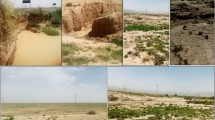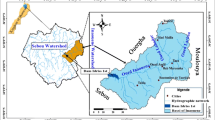Abstract
Soil erosion is a serious environmental problem in Guizhou Province, which is located in the centre of the karst areas of southwestern China. Unfortunately, Guizhou Province suffers from a lack of financial resources to research, monitor and model soil erosion at large watershed. In order to assess the soil erosion risk, soil erosion modeling at the watershed scale are urgently needed to be undertaken. This study integrated the Revised Universal Soil Loss Equation (RUSLE) with a Geographic Information System (GIS) to estimate soil loss and identify the risk erosion areas in the Maotiao River watershed, which is a typical rural watershed in Guizhou Province. All factors used in the RUSLE were calculated for the watershed using local data. It was classified into five categories ranging from minimal risk to extreme erosion risk depending on the calculated soil erosion amount. The soil erosion map was linked to land use, elevation and slope maps to explore the relationship between soil erosion and environmental factors and identify the areas of soil erosion risk. The results can be used to advice the local government in prioritizing the areas of immediate erosion mitigation. The integrated approach allows for relatively easy, fast, and cost-effective estimation of spatially distributed soil erosion. It thus indicates that RUSLE-GIS model is a useful and efficient tool for evaluating and mapping soil erosion risk at a large watershed scale in Guizhou Province.
Similar content being viewed by others
References
Agricultural Synthetical Regionalization Staff of Guizhou Province. (1988). Agricultural synthetical regionalization in Guizhou. Guizhou People Press: Guiyang, China.
Angima, S. D., Stott, D. E., O’Neill, M. K., Ong, C. K., & Weesies, G. A. (2003). Soil erosion prediction using RUSLE for central Kenyan highland conditions. Agriculture, Ecosystems, and Environment, 97, 295–308.
Cai, C., Ding, S., & Shi, Z. (2000). Study of applying USLE and Geographical Information System IDRISI to predict soil erosion in small watershed. Bulletin of Soil and Water Conservation, 2, 19–24.
Deng, P., Tu, Y., & Chen, G. (2003). Assessment of economic cost of soil erosion – A case study of Guizhou Province. Rural Eco-environment, 2, 1–5.
Department of Earth Science, Chinese Academy of Sciences. (2003). Suggestions for management of rocky densification in karst areas of southwestern China. Advances in Earth Sciences, 4, 489–492.
Fu, B., Zhao, W., & Chen, L. (2005). Assessment of soil erosion at larger watershed scale using RUSLE and GIS: a case study in the loess plateau of China. Land Degradation Development, 16, 73–85.
Gao, H., & Li, R. (2006). Analysis on regional soil and water loss based on geological scale in Guizhou Province. Bulletin of Soil and Water Conservation, 3, 118–121.
He, T. B. (2000). Status of soil and water loss and counter measures of ecological agriculture construction in Guizhou karst mountainous region. Journal of Soil Water Conservation, 5, 28–34.
Hickey, R. (2000). Slope angle and slope length solutions for GIS. Cartography, 29, 1–8.
Lee, G. S., & Lee, H. S. (2006). Scaling effect for estimating soil loss in the RUSLE model using remotely sensed geospatial data in Korea. Hydrology and Earth System Sciences Discussions, 3, 135–157.
Lin, C., & Zhu, A. (1999). Study on soil erosion and prevention in karst mountainous region of Guizhou. Research of Soil and Water Conservation, 2, 109–113.
Liu, B., Xie, Y., & Zhang, K. (2001). Soil loss prediction model. Beijing, China: China Science & Technology.
Lu, D., Li, G., Valladares,G., & Batistella, M. (2004). Mapping soil erosion risk in Rondonia, Brazilian Amazonia: Using RUSLE, remote sensing and GIS. Land Degradation & Development, 15, 499–512.
Oldeman, L. R. (1994). The global extent of soil degradation. In D. J. Greenland & I. Szabolcs (Eds.). Soil resilience and sustainable land use. Wallingford, UK: CAB.
Parysow, P., Wang, G. X., Gertner, G., & Anderson, A. B. (2003). Spatial uncertainty analysis for mapping soil erodibility based on joint sequential simulation. Catena, 53, 65–78.
Renard, K. G., Foster, G. R., Weesies, G. A., McCool, D. K., & Yoder, D. C. (1997). Predicting soil erosion by water – a guide to conservation planning with the Revised Universal Soil Loss Equation (RUSLE) Handbook no. 703. United States Department of Agriculture, United States Government Printing Office: Washington, DC.
Van Remortel, R., Hamilton, M., & Hickey, R. (2001). Estimating the LS factor for RUSLE through iterative slope length processing of digital elevation data within ArcInfo grid. Cartography, 30, 27–35.
Wan, J. (2003). Land degradation and ecological rehabilitation in karst areas of Guizhou Province, southwestern China. Advances in Earth Sciences, 3, 447–453.
Wang, W. (2001). Investigation of land erosion model of Houzhaihe catchment in Puding, Guizhou and its application. Guizhou Geology, 2, 99–106.
Wang, S., Liu, Q., & Zhang, D. (2004). Karst rocky desertification in southwestern China: Geomorphology, landuse, impact and rehabilitation. Land Degradation and Development, 15, 115–121.
Wischmeier, W. H. (1971). A soil erodibility nomograph for farmland and construction sites. Journal of Soil and Water Conservation, 26, 189–193.
Wu, S., Zhu, W., Su, W., Li, P., He, W., & Zhou, Q. (2005). Experiment on soil erosion and natural loss in karst area – A case in Jiuchang town, Xiuwen, Guiyang. Carsologica Sinica, 3, 202–205.
Xu, Y. (1991). Meteorology in Southwestern China. Beijing, China: Meteorological.
Xu, Y., Zhou, Q., & Li, S. (2005). An analysis on spatial–temporal distribution of rainfall erosivity in Guizhou Province. Bulletin of Soil and Water Conservation, 4, 11–14.
Yang, Z. (2002). Study on soil loss equation in Jinsha River basin of Yunnan province. Journal of Mountain Science, Supp, 1–9.
Yang, Z. (1999). Study on soil loss equation of cultivated slope land in Northeast mountain region of Yunnan province. Bullet of Soil and Water Conservation, 1, 1–9.
Yu, B., & Rosewell, C. J. (1998). Rainfall erosivity and its estimation for Australia’s tropics. Australian Journal of Soil Research, 36, 143–165.
Zhang, D., Wang, S., & Zhou, D. (2001). Intrinsic driving mechanism of land rocky desertification in karst regions of Guizhou Province. Bulletin of Soil and Water Conservation, 4, 1–5.
Zhang, B., Xiao, F., Wu, H., & Mo, S. (2006). Combating the fragile karst environment in Guizhou, China. Ambio, 2, 94–96.
Zhu, A., Lin, C., & Yang, H. (1994). A study on synthetical evaluation influencing factor of soil and water loss in Guizhou mountainous areas. Journal of Soil and Water conservation, 4, 17–24.
Author information
Authors and Affiliations
Corresponding author
Rights and permissions
About this article
Cite this article
Yue-Qing, X., Xiao-Mei, S., Xiang-Bin, K. et al. Adapting the RUSLE and GIS to model soil erosion risk in a mountains karst watershed, Guizhou Province, China. Environ Monit Assess 141, 275–286 (2008). https://doi.org/10.1007/s10661-007-9894-9
Received:
Accepted:
Published:
Issue Date:
DOI: https://doi.org/10.1007/s10661-007-9894-9




